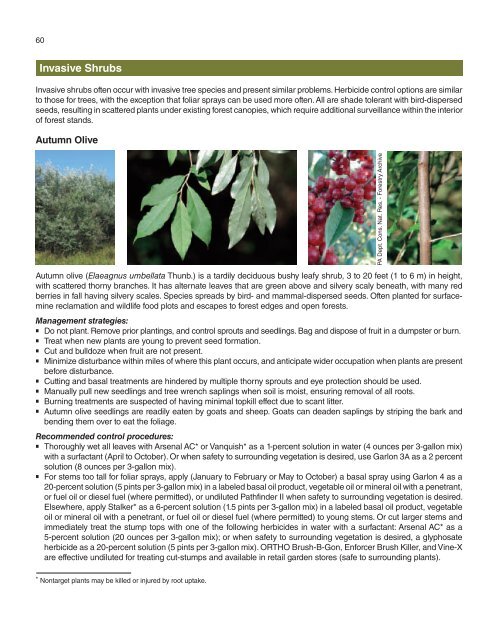A Management Guide for Invasive Plants in Southern Forests James ...
A Management Guide for Invasive Plants in Southern Forests James ...
A Management Guide for Invasive Plants in Southern Forests James ...
- No tags were found...
You also want an ePaper? Increase the reach of your titles
YUMPU automatically turns print PDFs into web optimized ePapers that Google loves.
60<strong>Invasive</strong> Shrubs<strong>Invasive</strong> shrubs often occur with <strong>in</strong>vasive tree species and present similar problems. Herbicide control options are similarto those <strong>for</strong> trees, with the exception that foliar sprays can be used more often. All are shade tolerant with bird-dispersedseeds, result<strong>in</strong>g <strong>in</strong> scattered plants under exist<strong>in</strong>g <strong>for</strong>est canopies, which require additional surveillance with<strong>in</strong> the <strong>in</strong>teriorof <strong>for</strong>est stands.Autumn OlivePA Dept. Cons. Nat. Res. - Forestry ArchiveAutumn olive (Elaeagnus umbellata Thunb.) is a tardily deciduous bushy leafy shrub, 3 to 20 feet (1 to 6 m) <strong>in</strong> height,with scattered thorny branches. It has alternate leaves that are green above and silvery scaly beneath, with many redberries <strong>in</strong> fall hav<strong>in</strong>g silvery scales. Species spreads by bird- and mammal-dispersed seeds. Often planted <strong>for</strong> surfacem<strong>in</strong>ereclamation and wildlife food plots and escapes to <strong>for</strong>est edges and open <strong>for</strong>ests.<strong>Management</strong> strategies:Do not plant. Remove prior plant<strong>in</strong>gs, and control sprouts and seedl<strong>in</strong>gs. Bag and dispose of fruit <strong>in</strong> a dumpster or burn.Treat when new plants are young to prevent seed <strong>for</strong>mation.Cut and bulldoze when fruit are not present.M<strong>in</strong>imize disturbance with<strong>in</strong> miles of where this plant occurs, and anticipate wider occupation when plants are presentbe<strong>for</strong>e disturbance.Cutt<strong>in</strong>g and basal treatments are h<strong>in</strong>dered by multiple thorny sprouts and eye protection should be used.Manually pull new seedl<strong>in</strong>gs and tree wrench sapl<strong>in</strong>gs when soil is moist, ensur<strong>in</strong>g removal of all roots.Burn<strong>in</strong>g treatments are suspected of hav<strong>in</strong>g m<strong>in</strong>imal topkill effect due to scant litter.Autumn olive seedl<strong>in</strong>gs are readily eaten by goats and sheep. Goats can deaden sapl<strong>in</strong>gs by strip<strong>in</strong>g the bark andbend<strong>in</strong>g them over to eat the foliage.Recommended control procedures:Thoroughly wet all leaves with Arsenal AC* or Vanquish* as a 1-percent solution <strong>in</strong> water (4 ounces per 3-gallon mix)with a surfactant (April to October). Or when safety to surround<strong>in</strong>g vegetation is desired, use Garlon 3A as a 2 percentsolution (8 ounces per 3-gallon mix).For stems too tall <strong>for</strong> foliar sprays, apply (January to February or May to October) a basal spray us<strong>in</strong>g Garlon 4 as a20-percent solution (5 p<strong>in</strong>ts per 3-gallon mix) <strong>in</strong> a labeled basal oil product, vegetable oil or m<strong>in</strong>eral oil with a penetrant,or fuel oil or diesel fuel (where permitted), or undiluted Pathf<strong>in</strong>der II when safety to surround<strong>in</strong>g vegetation is desired.Elsewhere, apply Stalker* as a 6-percent solution (1.5 p<strong>in</strong>ts per 3-gallon mix) <strong>in</strong> a labeled basal oil product, vegetableoil or m<strong>in</strong>eral oil with a penetrant, or fuel oil or diesel fuel (where permitted) to young stems. Or cut larger stems andimmediately treat the stump tops with one of the follow<strong>in</strong>g herbicides <strong>in</strong> water with a surfactant: Arsenal AC* as a5-percent solution (20 ounces per 3-gallon mix); or when safety to surround<strong>in</strong>g vegetation is desired, a glyphosateherbicide as a 20-percent solution (5 p<strong>in</strong>ts per 3-gallon mix). ORTHO Brush-B-Gon, En<strong>for</strong>cer Brush Killer, and V<strong>in</strong>e-Xare effective undiluted <strong>for</strong> treat<strong>in</strong>g cut-stumps and available <strong>in</strong> retail garden stores (safe to surround<strong>in</strong>g plants).* Nontarget plants may be killed or <strong>in</strong>jured by root uptake.
















